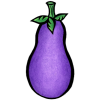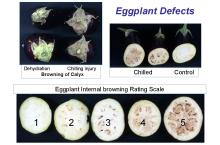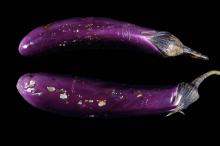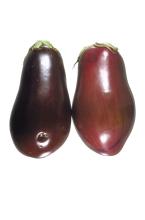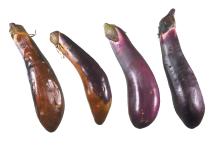Maturity and Quality
Eggplant fruit are harvested at a range of developmental stages. Depending on cultivar and temperature, the time from flowering to harvest may be 10 to 40 days. Generally fruit are harvested immature before seeds begin to significantly enlarge and harden. Firmness and external glossiness are also indicators of a pre-maturity condition. Eggplant fruit become pithy and bitter as they reach an overmature condition.
The diversity of eggplant types being marketed has increased greatly in recent years. Standard (American) eggplant quality is primarily based on uniform egg to globular shape, firmness and a dark purple skin color. Additional quality indices are size, freedom from growth or handling defects, freedom from decay, and a fresh green calyx. Other eggplant types include:
- Japanese - elongated, slender, light to dark purple, very perishable
- White - small egg shaped to globular, thin skinned
- Mini-Japanese - small elongate, striated purple and violet
- Chinese - elongated, slender, light purple
U.S. grades are Fancy, No. 1, and No. 2, and No. 3. Distinction among grades is based solely on size, external appearances, and firmness.
Postharvest Handling and Storage
10-12°C (50-54°F)
Storage of eggplant is generally less than 14 days as visual and sensory qualities deteriorate rapidly. Decay is likely to increase following storage beyond two weeks, especially after removal to typical retail conditions. Short term storage or transit temperatures below this range are used often to reduce weight loss, but will result in chilling injury after several days.
Chilling Injury. Eggplant fruit are chilling sensitive at temperatures below 10°C (50°F). At 5°C (41°F) chilling injury will occur in 6-8 days. Consequences of chilling injury are pitting, surface bronzing, and browning of seeds and pulp tissue. Accelerated decay by Alternaria spp. is common in chilling stressed fruit. Chilling injury is cumulative and may be initiated in the field prior to harvest.
Days to Visible Chilling Symptoms on each type:
| Temperature | 0°C (32°F) | 2.5°C (36°F) | 5°C (41°F) | 7.5°C (45°F) |
| American | 1-2 | 4-5 | 6-7 | 12 |
| Japanese | - | 5-6 | 8-9 | 12-14 |
| Chinese | 2-3 | 5-6 | 10-12 | 15-16 |
| Temperature | 12.5°C (55°F) |
| ml CO2/kg·hr American | 30-39 |
| ml CO2/kg·hr White egg | 52-61 |
| ml CO2/kg·hr Japanese | 62-69 |
To calculate heat production, multiply ml CO2/kg·hr by 440 to get BTU/ton/day or by 122 to get kcal/metric ton /day.
Eggplant fruit have a moderate to high sensitivity to exogenous ethylene. Calyx abscission and increased deterioration, particularly browning, may be a problem if eggplants are exposed to >1ppm ethylene during distribution and short-term storage.
90-95% R.H.
0.1-0.7 µl/kg·hr at 12.5°C (55°F)
Temperature & Controlled Atmosphere Photos
Disorders
See Chilling injury.
Freezing Injury. Freezing injury will be initiated at -0.8°C (30.6°F), depending on the soluble solids content. Symptoms of freezing injury include a watersoaked pulp becoming brown and desiccated in appearance over time.
Harvesting should be done by cutting the calyx-stem free from the plant rather than by tearing. Cotton gloves are often used.
Bruising and compression injury are very common when attention to careful harvest and handling practices are not followed. Eggplant cannot withstand stacking in bulk containers.
Diseases are an important source of postharvest loss, particularly in combination with chilling stress. Common fungal pathogens are Alternaria (Black Mold Rot), Botrytis (Gray Mold Rot), Rhizopus (Hairy Rot), and Phomopsis Rot.
Rapid cooling, primarily to reduce water loss, soon after harvest is essential for optimal postharvest keeping quality. The precooling endpoint is typically 10°C (50°F). Forced-air cooling is the most effective practice. Room cooling after washing or hydrocooling is the most common practice. Moistened paper or waxed cartons are often used to reduce water loss. Japanese eggplants lose water 3 times more rapidly than American-type eggplants. Visible signs of water loss are reduction of surface sheen, skin wrinkling, spongy flesh, and browning of the calyx.
Chilling injury and water loss can be reduced by storing of eggplant in polyethylene bags or polymeric film overwraps. Increased decay from Botrytis is a potential risk of this practice.



